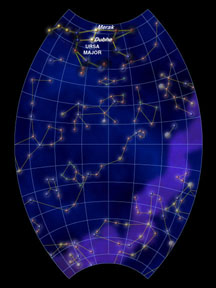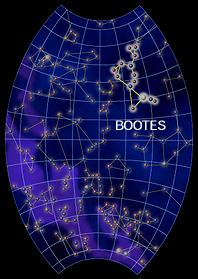Click on image for full size
Windows to the Universe original image
Related links:
Ursa Major
Ursa Major is probably the most famous constellation, with the exception of Orion. Also known as the Great Bear, it has a companion called Ursa Minor, or Little Bear. The body and tail of the bear make up what is known as the Big Dipper. Also called names such as the Plough, the Wain and even the Wagon, this constellation has a lot of history behind it.
Several different cultures saw a big bear in the sky. The ancient Greeks had a few different stories to explain how the animal ended up there. In one story, Hera discovered Zeus was having an affair with Callisto and turned her into a bear. Zeus put her in the sky along with her son, Arcas, who became the Little Bear.
Ursa Major is full of unique celestial objects. Two of the stars, Dubhe and Merak, are pointer stars. If you are looking at the Big Dipper, the outer edge stars that make up the "bowl" of the dipper are the two stars, with Merak being the one on top. Connect a line between the two, and extend it north a distance about five times the distance between them. It will connect with the North Star, Polaris.
If you connect the handle of the dipper with a line, it will lead to the star, Arcturus, in the constellation, Bootes. In one Greek myth, the star represented the guardian, Arcturus, who kept the bears from straying from their path. Above the head of the bear are two galaxies, M81 and M82. Both are 12 million light years away, but M81 is one of the brightest galaxies in the sky. Finally, the Owl Nebula is located to the lower left of Dubhe. It is so named because some photographs reveal what looks like a pair of eyes.
Most of the constellation is circumpolar, which means it can be viewed all year long. However, parts of the legs will disappear from the sky in the fall and reappear in the winter.













